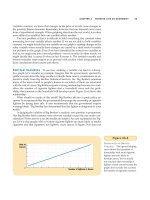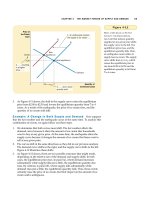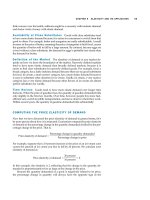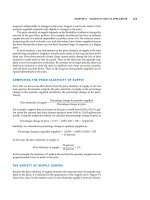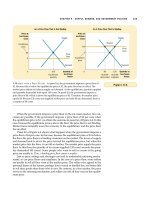Tài liệu Ten Principles of Economics - Part 23 ppt
Bạn đang xem bản rút gọn của tài liệu. Xem và tải ngay bản đầy đủ của tài liệu tại đây (301.66 KB, 10 trang )
CHAPTER 11 PUBLIC GOODS AND COMMON RESOURCES 229
that anyone can use without charge. Because knowledge is a public good, profit-
seeking firms tend to free ride on the knowledge created by others and, as a result,
devote too few resources to the creation of knowledge.
In evaluating the appropriate policy toward knowledge creation, it is impor-
tant to distinguish general knowledge from specific, technological knowledge.
Specific, technological knowledge, such as the invention of a better battery, can be
patented. The inventor thus obtains much of the benefit of his invention, although
certainly not all of it. By contrast, a mathematician cannot patent a theorem; such
general knowledge is freely available to everyone. In other words, the patent sys-
tem makes specific, technological knowledge excludable, whereas general knowl-
edge is not excludable.
The government tries to provide the public good of general knowledge in var-
ious ways. Government agencies, such as the National Institutes of Health and the
National Science Foundation, subsidize basic research in medicine, mathematics,
physics, chemistry, biology, and even economics. Some people justify government
funding of the space program on the grounds that it adds to society’s pool of
knowledge. Certainly, many private goods, including bullet-proof vests and the in-
stant drink Tang, use materials that were first developed by scientists and engi-
neers trying to land a man on the moon. Determining the appropriate level of
governmental support for these endeavors is difficult because the benefits are hard
to measure. Moreover, the members of Congress who appropriate funds for re-
search usually have little expertise in science and, therefore, are not in the best po-
sition to judge what lines of research will produce the largest benefits.
Fighting Poverty
Many government programs are aimed at helping the
poor. The welfare system (officially called Temporary Assistance for Needy Fami-
lies) provides a small income for some poor families. Similarly, the Food Stamp
program subsidizes the purchase of food for those with low incomes, and various
government housing programs make shelter more affordable. These antipoverty
programs are financed by taxes on families that are financially more successful.
“I like the concept if we can do it with no new taxes.”
230 PART FOUR THE ECONOMICS OF THE PUBLIC SECTOR
CASE STUDY
ARE LIGHTHOUSES PUBLIC GOODS?
Some goods can switch between being public goods and being private goods
depending on the circumstances. For example, a fireworks display is a public
good if performed in a town with many residents. Yet if performed at a private
amusement park, such as Walt Disney World, a fireworks display is more like a
private good because visitors to the park pay for admission.
Another example is a lighthouse. Economists have long used lighthouses as
examples of a public good. Lighthouses are used to mark specific locations so
that passing ships can avoid treacherous waters. The benefit that the lighthouse
provides to the ship captain is neither excludable nor rival, so each captain has
an incentive to free ride by using the lighthouse to navigate without paying for
the service. Because of this free-rider problem, private markets usually fail to
provide the lighthouses that ship captains need. As a result, most lighthouses
today are operated by the government.
Economists disagree among themselves about what role the government
should play in fighting poverty. Although we will discuss this debate more fully in
Chapter 20, here we note one important argument: Advocates of antipoverty pro-
grams claim that fighting poverty is a public good.
Suppose that everyone prefers to live in a society without poverty. Even if this
preference is strong and widespread, fighting poverty is not a “good” that the pri-
vate market can provide. No single individual can eliminate poverty because the
problem is so large. Moreover, private charity is hard pressed to solve the problem:
People who do not donate to charity can free ride on the generosity of others. In
this case, taxing the wealthy to raise the living standards of the poor can make
everyone better off. The poor are better off because they now enjoy a higher stan-
dard of living, and those paying the taxes are better off because they enjoy living
in a society with less poverty.
U
SE OF THE LIGHTHOUSE IS FREE TO THE BOAT OWNER
. D
OES THIS MAKE THE LIGHTHOUSE A PUBLIC GOOD
?
CHAPTER 11 PUBLIC GOODS AND COMMON RESOURCES 231
In some cases, however, lighthouses may be closer to private goods. On the
coast of England in the nineteenth century, some lighthouses were privately
owned and operated. The owner of the local lighthouse did not try to charge
ship captains for the service but did charge the owner of the nearby port. If the
port owner did not pay, the lighthouse owner turned off the light, and ships
avoided that port.
In deciding whether something is a public good, one must determine the
number of beneficiaries and whether these beneficiaries can be excluded from
enjoying the good. A free-rider problem arises when the number of beneficiaries
is large and exclusion of any one of them is impossible. If a lighthouse benefits
many ship captains, it is a public good. Yet if it primarily benefits a single port
owner, it is more like a private good.
THE DIFFICULT JOB OF COST-BENEFIT ANALYSIS
So far we have seen that the government provides public goods because the pri-
vate market on its own will not produce an efficient quantity. Yet deciding that the
government must play a role is only the first step. The government must then de-
termine what kinds of public goods to provide and in what quantities.
Suppose that the government is considering a public project, such as building
a new highway. To judge whether to build the highway, it must compare the total
benefits of all those who would use it to the costs of building and maintaining it.
To make this decision, the government might hire a team of economists and engi-
neers to conduct a study, called a cost-benefit analysis, the goal of which is to es-
timate the total costs and benefits of the project to society as a whole.
Cost-benefit analysts have a tough job. Because the highway will be available
to everyone free of charge, there is no price with which to judge the value of the
highway. Simply asking people how much they would value the highway is not
reliable. First, quantifying benefits is difficult using the results from a question-
naire. Second, respondents have little incentive to tell the truth. Those who would
use the highway have an incentive to exaggerate the benefit they receive to get the
highway built. Those who would be harmed by the highway have an incentive to
exaggerate the costs to them to prevent the highway from being built.
The efficient provision of public goods is, therefore, intrinsically more difficult
than the efficient provision of private goods. Private goods are provided in the
market. Buyers of a private good reveal the value they place on it by the prices
they are willing to pay. Sellers reveal their costs by the prices they are willing to
accept. By contrast, cost-benefit analysts do not observe any price signals when
evaluating whether the government should provide a public good. Their findings
on the costs and benefits of public projects are, therefore, rough approximations
at best.
cost-benefit analysis
a study that compares the costs and
benefits to society of providing a
public good
CASE STUDY
HOW MUCH IS A LIFE WORTH?
Imagine that you have been elected to serve as a member of your local town
council. The town engineer comes to you with a proposal: The town can spend
$10,000 to build and operate a traffic light at a town intersection that now has
only a stop sign. The benefit of the traffic light is increased safety. The engineer
232 PART FOUR THE ECONOMICS OF THE PUBLIC SECTOR
estimates, based on data from similar intersections, that the traffic light would
reduce the risk of a fatal traffic accident over the lifetime of the traffic light from
1.6 to 1.1 percent. Should you spend the money for the new light?
To answer this question, you turn to cost-benefit analysis. But you quickly
run into an obstacle: The costs and benefits must be measured in the same units
if you are to compare them meaningfully. The cost is measured in dollars, but
the benefit—the possibility of saving a person’s life—is not directly monetary.
To make your decision, you have to put a dollar value on a human life.
At first, you may be tempted to conclude that a human life is priceless. Af-
ter all, there is probably no amount of money that you could be paid to volun-
tarily give up your life or that of a loved one. This suggests that a human life
has an infinite dollar value.
For the purposes of cost-benefit analysis, however, this answer leads to
nonsensical results. If we truly placed an infinite value on human life, we
should be placing traffic lights on every street corner. Similarly, we should all be
driving large cars with all the latest safety features, instead of smaller ones with
fewer safety features. Yet traffic lights are not at every corner, and people some-
times choose to buy small cars without side-impact air bags or antilock brakes.
In both our public and private decisions, we are at times willing to risk our lives
to save some money.
Once we have accepted the idea that a person’s life does have an implicit
dollar value, how can we determine what that value is? One approach, some-
times used by courts to award damages in wrongful-death suits, is to look at the
total amount of money a person would have earned if he or she had lived.
Economists are often critical of this approach. It has the bizarre implication that
the life of a retired or disabled person has no value.
A better way to value human life is to look at the risks that people are vol-
untarily willing to take and how much they must be paid for taking them. Mor-
tality risk varies across jobs, for example. Construction workers in high-rise
buildings face greater risk of death on the job than office workers do. By com-
paring wages in risky and less risky occupations, controlling for education, ex-
perience, and other determinants of wages, economists can get some sense
about what value people put on their own lives. Studies using this approach
conclude that the value of a human life is about $10 million.
E
VERYONE WOULD
LIKE TO AVOID THE
RISK OF THIS
,
BUTAT
WHATCOST
?
CHAPTER 11 PUBLIC GOODS AND COMMON RESOURCES 233
We can now return to our original example and respond to the town engi-
neer. The traffic light reduces the risk of fatality by 0.5 percent. Thus, the ex-
pected benefit from having the traffic light is 0.005 ϫ $10 million, or $50,000.
This estimate of the benefit well exceeds the cost of $10,000, so you should ap-
prove the project.
C
OST
-
BENEFIT ANALYSTS OFTEN RUN INTO
hard questions. Here’s an example.
They Exist. Therefore They
Are. But, Do You Care?
B
Y
S
AM
H
OWE
V
ERHOVEK
It sounds like a philosophical cousin to
the age-old question of whether a tree
falling in the forest makes a sound if no
one is around to hear it. In this case,
though, federal officials are seeking to
add an economic variable to the puzzle:
Just how much is it worth to
you
to know
that a once-dammed river is running wild
again—even if you never visit it?
In the midst of a major study of
whether or not to breach four huge hy-
droelectric dams on the Snake River in
eastern Washington, economists with
the Army Corps of Engineers are adding
a factor known as “existence value” to
their list of costs and benefits of the con-
tentious proposal.
Breaching the dams would restore
140 miles of the lower Snake to its wild,
free-flowing condition and would, many
biologists argue, stand a good chance of
revitalizing endangered salmon runs in
the river. Aside from calculating the pro-
posal’s effects on jobs, electric bills, and
shipping rates, the Government is now
hoping to assign a dollar value to Ameri-
cans’ knowledge that a piece of their
wilderness might be regained. . . .
“The idea that you’d be willing to
pay something for some state of the
world to exist, as you would pay for a
commodity or a contract for services, is
not at all crazy,” said Alan Randall, chair-
man of the department of agricultural,
environmental, and development eco-
nomics at Ohio State University. “The
controversy, really, is mostly about
measurability.”
Proponents of the dam-breaching
proposal have pointed to polls suggest-
ing that Seattle-area residents would be
willing to pay a few extra dollars a month
on their electricity bills into order to save
salmon runs. . . . Economists at the
Corps of Engineers have calculated that
breaching the four Snake River dams
and successfully restoring the salmon is
an idea for which Americans would be
willing to shell out [in total] as much as
$1 billion. . . .
Others question whether such a
value can be accurately measured. “The
only way to do it is to ask people what
they would be willing to pay, and in my
view you ask people questions like that
and you get very upwardly biased re-
sults,” said Jerry Hausman, an econom-
ics professor at M.I.T. “When somebody
calls you on the phone to ask, it’s not
real money.”
S
OURCE
: The New York Times, Week in Review,
October 17, 1999, p. 5.
IN THE NEWS
Existence Value
QUICK QUIZ: What is the free-rider problem? ◆ Why does the free-rider
problem induce the government to provide public goods? ◆ How should the
government decide whether to provide a public good?
COMMON RESOURCES
Common resources, like public goods, are not excludable: They are available free of
charge to anyone who wants to use them. Common resources are, however, rival:
